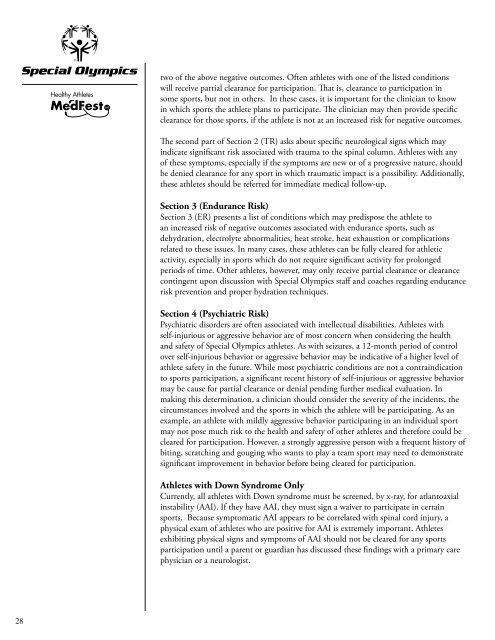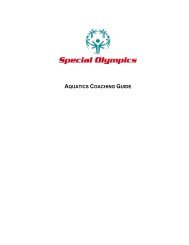MedFest Manual for Clinical Directors - Special Olympics
MedFest Manual for Clinical Directors - Special Olympics
MedFest Manual for Clinical Directors - Special Olympics
You also want an ePaper? Increase the reach of your titles
YUMPU automatically turns print PDFs into web optimized ePapers that Google loves.
28<br />
two of the above negative outcomes. Often athletes with one of the listed conditions<br />
will receive partial clearance <strong>for</strong> participation. That is, clearance to participation in<br />
some sports, but not in others. In these cases, it is important <strong>for</strong> the clinician to know<br />
in which sports the athlete plans to participate. The clinician may then provide specific<br />
clearance <strong>for</strong> those sports, if the athlete is not at an increased risk <strong>for</strong> negative outcomes.<br />
The second part of Section 2 (TR) asks about specific neurological signs which may<br />
indicate significant risk associated with trauma to the spinal column. Athletes with any<br />
of these symptoms, especially if the symptoms are new or of a progressive nature, should<br />
be denied clearance <strong>for</strong> any sport in which traumatic impact is a possibility. Additionally,<br />
these athletes should be referred <strong>for</strong> immediate medical follow-up.<br />
Section 3 (Endurance Risk)<br />
Section 3 (ER) presents a list of conditions which may predispose the athlete to<br />
an increased risk of negative outcomes associated with endurance sports, such as<br />
dehydration, electrolyte abnormalities, heat stroke, heat exhaustion or complications<br />
related to these issues. In many cases, these athletes can be fully cleared <strong>for</strong> athletic<br />
activity, especially in sports which do not require significant activity <strong>for</strong> prolonged<br />
periods of time. Other athletes, however, may only receive partial clearance or clearance<br />
contingent upon discussion with <strong>Special</strong> <strong>Olympics</strong> staff and coaches regarding endurance<br />
risk prevention and proper hydration techniques.<br />
Section 4 (Psychiatric Risk)<br />
Psychiatric disorders are often associated with intellectual disabilities. Athletes with<br />
self-injurious or aggressive behavior are of most concern when considering the health<br />
and safety of <strong>Special</strong> <strong>Olympics</strong> athletes. As with seizures, a 12-month period of control<br />
over self-injurious behavior or aggressive behavior may be indicative of a higher level of<br />
athlete safety in the future. While most psychiatric conditions are not a contraindication<br />
to sports participation, a significant recent history of self-injurious or aggressive behavior<br />
may be cause <strong>for</strong> partial clearance or denial pending further medical evaluation. In<br />
making this determination, a clinician should consider the severity of the incidents, the<br />
circumstances involved and the sports in which the athlete will be participating. As an<br />
example, an athlete with mildly aggressive behavior participating in an individual sport<br />
may not pose much risk to the health and safety of other athletes and there<strong>for</strong>e could be<br />
cleared <strong>for</strong> participation. However, a strongly aggressive person with a frequent history of<br />
biting, scratching and gouging who wants to play a team sport may need to demonstrate<br />
significant improvement in behavior be<strong>for</strong>e being cleared <strong>for</strong> participation.<br />
Athletes with Down Syndrome Only<br />
Currently, all athletes with Down syndrome must be screened, by x-ray, <strong>for</strong> atlantoaxial<br />
instability (AAI). If they have AAI, they must sign a waiver to participate in certain<br />
sports. Because symptomatic AAI appears to be correlated with spinal cord injury, a<br />
physical exam of athletes who are positive <strong>for</strong> AAI is extremely important. Athletes<br />
exhibiting physical signs and symptoms of AAI should not be cleared <strong>for</strong> any sports<br />
participation until a parent or guardian has discussed these findings with a primary care<br />
physician or a neurologist.

















